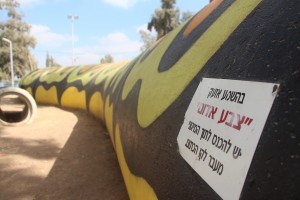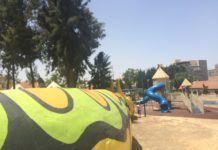SDEROT– Fifteen seconds is the difference between life and death for residents in a small village 100 kilometers from Jerusalem. In Sderot, an agricultural village just a stone’s throw from the Gaza border, the fear of attack weighs heavy on everyone’s mind.
A giant multicolored slide stands in the middle of a playground at Kibbutz Mefalsim just outside Sderot. The structure is between two white cement blocks painted with brown monkeys and green flowers, and a narrow opening on one side. These cement structures, which blend in so well with their surroundings, are for protection, not play. The blocks are bomb shelters.
“You always know a missile can land in your backyard,” said law student Noam Uerad standing next to the play structure. “You have learned to avoid a missile, but you never know when to expect an alarm.”
Sderot’s close proximity to the patrolled border with the Gaza Strip, complete with a barbed wire fence, makes it an easy target for Hamas and Al Qaeda-launched rockets and missiles.
Since 2001, more than 10,000 missiles have been launched toward Sderot, according to the Sderot Media Center, a nonprofit citizen journalism organization formed to bring attention to the community’s plight. Many of these remnants are on display at the local police station, while others are turned into intricate sculptures placed around the city.
The exposure to the intense, on-going threat of missile and mortar attacks is a major stressor for the city’s residents. Almost 50 percent of the village’s preteens suffer signs of post-traumatic related symptoms including reliving attacks, according to a 2012 study by Journal of Adolescent Health. Since the fighting between Israel and Hamas intensified in the early 2000s, depression and anxiety among the village’s residents has doubled, states a study set to be published in the journal of Israeli Medical Association.
But native Sivan Hanukayev disagrees, saying the village does not suffer from PTSD. The disease’s definition, she said, implies the fighting and violence are over.
“In Sderot it is an endless situation,” she said. “We are experiencing on-going trauma…”
Here, just 800 meters from the Gaza border, children grow up playing Lego next to and inside bomb shelters, waiting for missiles to strike land.
“There is an entire generation that doesn’t know anything else,” added Uerad.
Bomb shelters are more common in Sderot than coffee shops in any major North American city. In many schools, the cement structures are painted in vibrant colors or disguised as 25-foot caterpillars that span the length of a playground. Common sites including bus shelters, garages, and rooms in family homes; even community mailboxes are made to withstand a missile attack.
“Every kid born here has already experienced thousands of alarms,” emphasized Hanukayev, who can’t count how many attacks she has experienced.
Despite colorful paintjobs and clever designs, the city is always on alert. Children born and raised in Sderot, for the most part, know only a life of violence and terror. It’s their normal. The memories with the most impact are of violence and destruction.
“All those kids, their first memories, experiences and vacations, or forced vacations, happened because of the missiles,” added Hanukayev.
David Levi, 12, experienced his first rocket attack at age 4. His father parked the car at a nearby school, got out of the vehicle and took his sister to her kindergarten class. Levy was left alone in the backseat. Shortly after his father got back into the car, a rocket fell approximately 20 meters from their vehicle.
Levi is one of five smiling children in bright colored t-shirts standing against a white wall in the bomb shelter of his summer camp at Kibbutz Mefalsim. The pre-teens are sharing their first-hand experiences with rocket attacks.
Roni Tarnovski, 11, spent her 10th birthday in a bomb shelter following a rocket attack. In the evening, Tarnovski had to escape to an neighboring community. “It was scary,” she said.
Alon Cohen, an 11-year-old boy wearing a neon green t-shirt, begins to choke up as he speaks about one encounter with a rocket. Cohen was eating dinner at home with some friends when the warning siren went off. The boys, who were alone at the time, didn’t have a bomb shelter within sight so they hid under the dining room table. The experience, said Cohen, was stressful.
Kids like Cohen and Tarnovski are taught from a young age how to survive a missile attack. “Run to a shelter, or hide under a table,” said Tarnovski. While schools in other places conduct fire drills, in Sderot schoolchildren often perform routine bomb drills.
These training sessions work, but they take a toll on the students, said Anat Benami-Tarnovski, a mother and teacher at the camp. Two summers ago she had her students run from the deep water of a local swimming pool to the nearest shelter – all within 15 seconds. The test was tough, she admitted, and made the children aware of how fast they need to be when a siren sounds. This summer, she said, the students would not enter the deep water for fear of being too far from a shelter.
“It happens a lot,” she said about the frequency of missile strikes in her village. “It’s all the time.”
Regardless of their frequency, the attacks don’t seem to get any easier. The woman’s voice that echoes throughout the village when a warning siren goes off is etched into the memory of almost every resident, including the youngest children. Sometimes, however, residents are given no warning.
Despite a lifestyle plagued by the fear of the unknown, residents are optimistic about the future and about peace between Israel and Palestine. Many people living in Sderot will tell you they choose to live and stay in the war-afflicted village. For many, it’s where they have grown up and where they have made memories, both good and bad.
“It’s our responsibility to show we are not neglecting the people of Sderot because it can be unsafe,” said Uerad.
But it’s not just the adults that drive the optimistic spirit in this town: it’s the children.
“I really love this place no matter what,” said Levi, who sees himself as a symbol of a kid who should never abandon his home. Leaving this “magical place,” said Levi, means giving up.
“If we leave, they will have won,” he added. “Maybe sometime it will finish and it will be a nice place to live.”
http://www.huffingtonpost.ca/annie-claire-bergeron/sderot-israel_b_3592510.html











